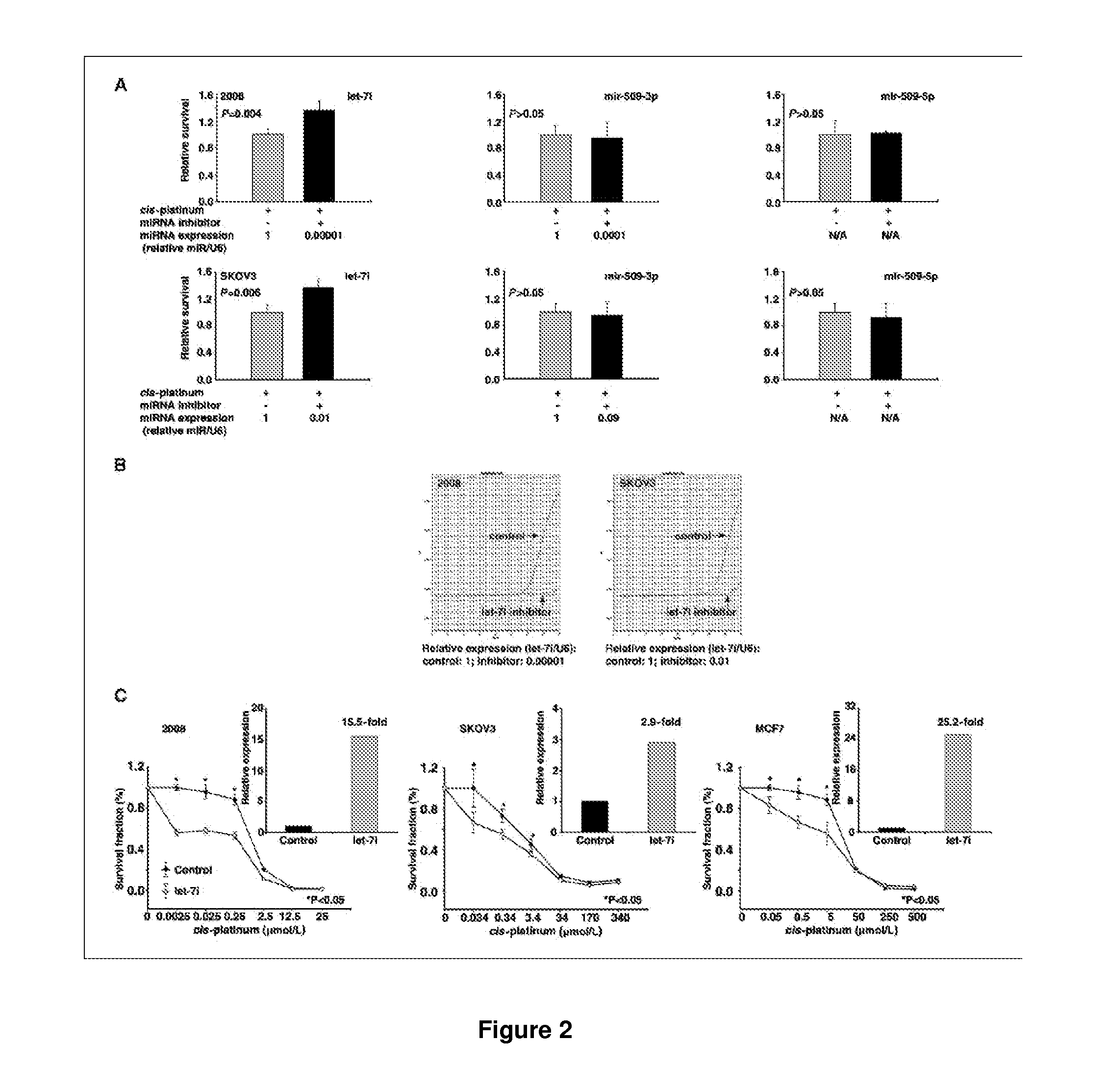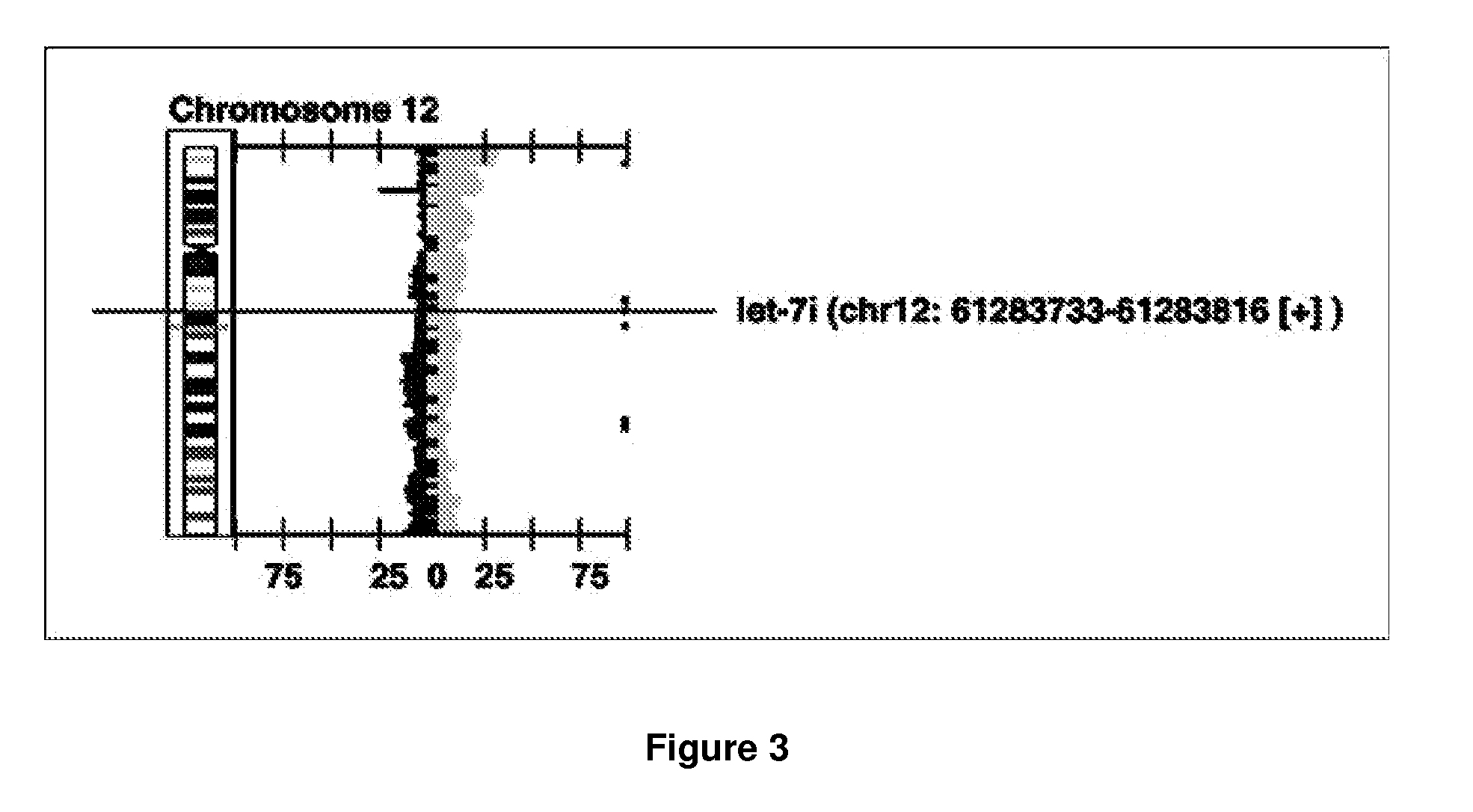Microrna biomarker in cancer
a biomarker and microrna technology, applied in the field of cancer chemotherapy response prediction and improvement, can solve the problems of enormous mirna-like regulatory circuitry
- Summary
- Abstract
- Description
- Claims
- Application Information
AI Technical Summary
Problems solved by technology
Method used
Image
Examples
example 2
Decreased Let-7i Expression Increases the Chemotherapy Resistance of EOC Cells
[0086]It was demonstrated that miRNAs are globally down-regulated in human cancers including EOC. Those down-regulated miRNAs, such as the Let-7 family, might serve as tumor suppressor genes and their suppression can have an important effect on tumor cells, e.g., by rendering them more resistant to cytotoxic anticancer therapy. Let-7i has been reported to be down-regulated in recurrent ovarian tumors compared with primary tumors. Therefore, to further investigate whether the above identified miRNAs are functionally involved in tumor resistance to chemotherapy, three miRNAs (Let-7i, mir-321, and mir-509; FIG. 1A) that were significantly repressed in the chemotherapy resistant tumors were focused on. mir-321, a fragment of Arg-tRNA, was excluded from the study, and both mature forms of mir-509 (mir-509-5p and mir-509-3p) were included. A total of three mature miRNAs, Let-7i, mir-509-5p, and mir-509-3p were e...
example 3
Let-7i DNA Copy Number Does Not Exhibit Genomic Alteration in Human Cancer
[0087]The molecular mechanism of Let-7i downregulation in patients with chemotherapy-resistant EOC is unclear. Previous studies indicated that DNA copy number of miRNAs is highly altered in human cancer including EOC, and DNA copy number alteration significantly contributes to miRNA expression in cancer. For example, Let-7a3 deletion was found in 31.2% of EOC specimens (n=106), which significantly reduced Let-7a3 expression in EOC. Therefore, the inventors of the instant application questioned whether DNA copy alteration of Let-7i contributes to the reduced expression of Let-7i in patients with chemotherapy-resistant EOC. In the 69 patients that were used for initial analysis of chemotherapy-associated miRNA markers, 30 were analyzed by aCGH (complete response patients, n=20; and noncomplete response patients, n=10). The inventors of the instant application first analyzed the genomic locus, Chr12—61-62 Mb, whi...
example 4
Low let-7i Expression Is Significantly Associated with Shorter Survival of Patients with EOC
[0088]It has been reported that the expression of Let-7 family is a strong prognostic marker for human cancer patients. In this study, the inventors of the instant application identified Let-7i as an important predictor for chemotherapy resistance in patients with EOC. The inventors of the instant application further investigated whether Let-7i could also serve as a prognostic marker in patients with EOC. To examine the correlation between Let-7i expression and rapid recurrence of the disease, the Let-7i expression was studied in 72 late-stage EOC patient samples by miRNA microarray. Kaplan-Meier survival analysis indicated that low expression of Let-7i was significantly associated with shorter progression-free survival of the patients as compared with the high Let-7i expression group (P=0.042, n=72; FIG. 4A). This result was further validated by a more accurate mature miRNA quantitative meth...
PUM
| Property | Measurement | Unit |
|---|---|---|
| time | aaaaa | aaaaa |
| volume | aaaaa | aaaaa |
| wavelength | aaaaa | aaaaa |
Abstract
Description
Claims
Application Information
 Login to View More
Login to View More - R&D
- Intellectual Property
- Life Sciences
- Materials
- Tech Scout
- Unparalleled Data Quality
- Higher Quality Content
- 60% Fewer Hallucinations
Browse by: Latest US Patents, China's latest patents, Technical Efficacy Thesaurus, Application Domain, Technology Topic, Popular Technical Reports.
© 2025 PatSnap. All rights reserved.Legal|Privacy policy|Modern Slavery Act Transparency Statement|Sitemap|About US| Contact US: help@patsnap.com



